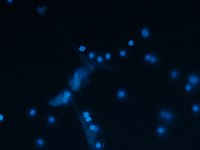
Photo from wikipedia
Abstract Aims Sirtuin 3 (Sirt3) is a mitochondrial, nicotinamide adenine dinucleotide (NAD+)-dependent deacetylase that reduces oxidative stress by activation of superoxide dismutase 2 (SOD2). Oxidative stress enhances arterial thrombosis. This… Click to show full abstract
Abstract Aims Sirtuin 3 (Sirt3) is a mitochondrial, nicotinamide adenine dinucleotide (NAD+)-dependent deacetylase that reduces oxidative stress by activation of superoxide dismutase 2 (SOD2). Oxidative stress enhances arterial thrombosis. This study investigated the effects of genetic Sirt3 deletion on arterial thrombosis in mice in an inflammatory setting and assessed the clinical relevance of these findings in patients with ST-elevation myocardial infarction (STEMI). Methods and results Using a laser-induced carotid thrombosis model with lipopolysaccharide (LPS) challenge, in vivo time to thrombotic occlusion in Sirt3−/− mice (n = 6) was reduced by half compared to Sirt3+/+ wild-type (n = 8, P < 0.01) controls. Ex vivo analyses of whole blood using rotational thromboelastometry revealed accelerated clot formation and increased clot stability in Sirt3−/− compared to wild-type blood. rotational thromboelastometry of cell-depleted plasma showed accelerated clotting initiation in Sirt3−/− mice, whereas overall clot formation and firmness remained unaffected. Ex vivo LPS-induced neutrophil extracellular trap formation was increased in Sirt3−/− bone marrow-derived neutrophils. Plasma tissue factor (TF) levels and activity were elevated in Sirt3−/− mice, whereas plasma levels of other coagulation factors and TF expression in arterial walls remained unchanged. SOD2 expression in bone marrow -derived Sirt3−/− neutrophils was reduced. In STEMI patients, transcriptional levels of Sirt3 and its target SOD2 were lower in CD14+ leukocytes compared with healthy donors (n = 10 each, P < 0.01). Conclusions Sirt3 loss-of-function enhances experimental thrombosis in vivo via an increase of neutrophil extracellular traps and elevation of TF suggesting thrombo-protective effects of endogenous Sirt3. Acute coronary thrombosis in STEMI patients is associated with lower expression levels of SIRT3 and SOD2 in CD14+ leukocytes. Therefore, enhancing SIRT3 activity by pan-sirtuin activating NAD+-boosters may provide a novel therapeutic target to prevent or treat thrombotic arterial occlusion in myocardial infarction or stroke.
Journal Title: Cardiovascular Research
Year Published: 2018
Link to full text (if available)
Share on Social Media: Sign Up to like & get
recommendations!